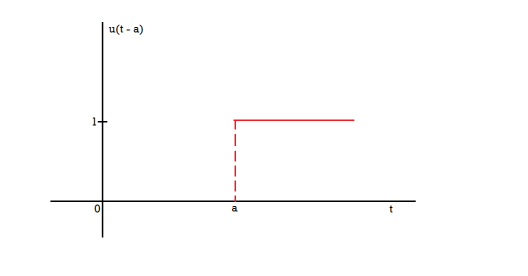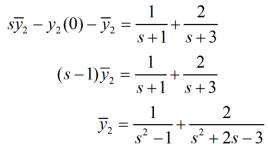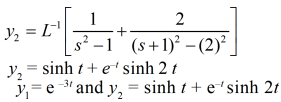Unit – 1
Laplace Transformation
Q1) What is Laplace transform?
A1)
Let f(t) be any function of t defined for all positive values of t. Then the Laplace transform of the function f(t) is defined as-

Provided that the integral exists, here ‘s’ is the parameter that could be real or complex.
The inverse of the Laplace transform can be defined as below-

Here 
f(t) is called the inverse Laplace transform of 
L is called the Laplace transformation operator.
Q2) Find the Laplace transform of the functions 
A2)
Here 
So that we can write it as-

Now-

Q3) Find the Laplace transform of (1 + cos 2t)
A3)





So that-

Q4) What is the linearity property of LT?
A4)
Let a and b be any two constants and  ,
,  any two functions of t, then-
any two functions of t, then-

Proof:


Hence proved.
Q5) Find the Laplace transform of t sin at.
A5)
Here-




Q6) Find the Laplace transform of the following function-

A6)
The given function f(t) can be written as-

So, by definition,



Q7) What do you understand by periodic function?
A7)
Suppose the function f(t) be periodic with period  , then-
, then-


Similarly-

Now-


Put t = z + in the second integral of the above equation and t = z + 2
in the second integral of the above equation and t = z + 2 in the third integral and so on.
in the third integral and so on.
We get-

F(t) is periodic with period  we can write-
we can write-


Here  is a geometric progression with a common ratio
is a geometric progression with a common ratio  , and we know that the sum of infinite terms in G.P. Is given by
, and we know that the sum of infinite terms in G.P. Is given by
Then-

Q8) Define unit step function.
A8)
Unit step function
The unit step function u(t – a) is defined as-


Laplace transform of unit functions-


Q9) Find the Laplace transform of the following function by using unit step function-

A9)


Since 


Q10) Evaluate- 
A10)
As we know that-



Q11) Find the inverse Laplace transform of-

A11)



Q12) Find 
A12)



Q13) Find the Laplace inverse of-

A13)
We will convert the function into partial fractions-




Q14) Find

A14)

Therefore by the convolution theorem-



Q15) Use Laplace transform method to solve the following equation-

A15)
Here we have-

Take Laplace transform of both sides, we get-

It becomes-
(
So that-

Now breaking it into partial fractions-

We get the following results on inversion-


Q16) Use Laplace transform method to solve the following equation-

A16)
Here we have-

Taking Laplace transform of both sides, we get-

We get on putting given values-

On inversion, we get-


Q17) solve the following differential equation by using Laplace transform-


Here D = d/dt and 
A17)
Here we have-


Now multiply (1) by D+1 and (2) by D – 1 we get-


Now subtract (4) from (3), we get-



By taking Laplace to transform we get-




Put the value of  in (1) we get-
in (1) we get-

By taking Laplace to transform we get-


Which is the required answer.
Q18) Find the inverse transform of-

A18)
First, we will convert it into partial fractions-

